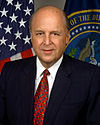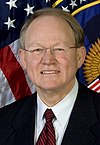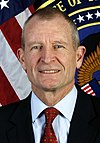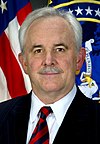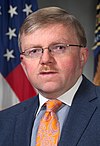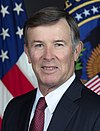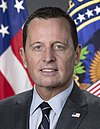Director of National Intelligence
| This article may be deleted soon. | ||||||||||||||||||||||||||||||||||||||||||||||||||||||||||||||||||||||||
|---|---|---|---|---|---|---|---|---|---|---|---|---|---|---|---|---|---|---|---|---|---|---|---|---|---|---|---|---|---|---|---|---|---|---|---|---|---|---|---|---|---|---|---|---|---|---|---|---|---|---|---|---|---|---|---|---|---|---|---|---|---|---|---|---|---|---|---|---|---|---|---|---|
The Director of National Intelligence (DNI) is the United States government official subject to the authority, direction and control of the President of the United States of America|President who is responsible under the Intelligence Reform and Terrorism Prevention Act of 2004 for:
Admiral Dennis Blair was confirmed on January 28, 2009, but James Clapper was confirmed as his replacement in August 2010. As was the case when the CIA headed the IC, the Director and Principal Deputy Director cannot both be active-duty military officers. A difference is that the Congress expressed a desire that one either be a military intelligence officer, usually of four-star rank, or have extensive experience in military intelligence. 50 U.S.C. § 403-3a Office of the Director of National Intelligence (ODNI)The Intelligence Reform and Terrorism Prevention Act of 2004 established the Office of the Director of National Intelligence (ODNI) as an independent agency to assist the DNI. The ODNI has about 1,500 employees. The National Counterterrorism Center is a major organization within the ODNI. On March 23, 2007, DNI Mike McConnell announced organizational changes, which include:
Principal Deputy Director of National IntelligenceDonald Kerr|Donald M. Kerr was confirmed by the U.S. Senate to be Principal Deputy Director of National Intelligence on 4 October 2007. Previously, he headed the National Reconnaissance Office, and he was previously the Deputy Director for Science and Technology at the U.S. Central Intelligence Agency (CIA). Earlier in his career, he was the Assistant Director of the Justice Department's Federal Bureau of Investigation (FBI). He received his Ph.D. from Cornell University. Director of the Intelligence StaffThe Office of the Director of the Intelligence Staff (DIS) is responsible for synchronizing and integrating efforts across the DNI staff and components. This is roughly equivalent to the Intelligence Community Staff, previously a CIA component. Offices that fall under the DIS include:
DDNI for CollectionThe Office of the Deputy Director of National Intelligence for Collection was established to coordinate collection throughout the Intelligence Community under the authorities of the DNI and ensure that the National Intelligence Strategy (NIS) priorities are appropriately reflected in future planning and systems acquisition decisions.[1] The Office of the DDNI for Collection looks across the entire collection business enterprise to develop corporate understanding of needs, requirements, and capabilities to ensure that a holistic view is taken on current and future collection systems. The Deputy Director for Collection brings together key IC stakeholders to get senior level insight into issues.[2] The DDNI for Collection is supported by four Assistant Deputies:
DDNI for AnalysisPrimary authority for analytic activities rests with the Deputy Director of National Intelligence for Analysis, who is also the Chairman of the National Intelligence Council. As of March 2007, there are six Assistant Deputy Directors for Analysis (ADDNI/A):[3]
100 Day/500 Day PlansThe Office of the Director of National Intelligence has released Intelligence Community 100 Day & 500 Day Plans for Integration & Collaboration. These plans include a series of initiatives designed to build the foundation for increased cooperation and reform of the U.S. Intelligence Community.[7] HistoryPrior to establishment of the DNI, the head of the United States Intelligence Community was the Director of Central Intelligence (DCI). The DCI concurrently served as the Director of the Central Intelligence Agency (CIA). Establishment of the DNI position was one of the recommendations in the 9/11 Commission Report|report by the National Commission on Terrorist Attacks Upon the United States|9/11 Commission investigating the 9/11|September 11 attacks. The report, which was released on July 22, 2004, identified major intelligence failures that called into question how well the Intelligence Community protected US national and homeland security interests against attacks by foreign terrorists. Soon thereafter Senators Dianne Feinstein, John D. Rockefeller IV and Bob Graham introduced legislation to create a Director of National Intelligence, S. 2645, introduced on June 19, 2002. Other, similar, legislation soon followed. After considerable debate on the scope of the DNI's powers and authorities, the United States Congress passed the Intelligence Reform and Terrorism Prevention Act of 2004 by votes of 336-75 in the U.S. House of Representatives|House of Representatives, and 89-2 in the United States Senate|Senate. President George W. Bush signed the bill into law on December 17, 2004. Among other things, the law established the DNI position as the designated leader of the United States Intelligence Community and prohibited the DNI from serving as the CIA Director or the head of any other Intelligence Community element at the same time. In addition, the law required the CIA Director to "report" his agency's activities to the DNI. Critics say compromises during the bill's crafting led to the establishment of a DNI whose powers are too weak to adequately lead, manage and improve the performance of the US Intelligence Community.[8] In particular, the law left the United States Department of Defense in charge of the National Security Agency (NSA), the National Reconnaissance Office (NRO), and the National Geospatial-Intelligence Agency. (The limited DNI role in leading the US Intelligence Community is discussed in the United States Intelligence Community|Intelligence Community article.) On February 17, 2005, President George W. Bush named U.S. Ambassador to Iraq John Negroponte to the post, pending United States Senate#Appointments|confirmation by the Senate. It was reported that President Bush's first choice for Director of National Intelligence was former Director of Central Intelligence Robert M. Gates, who was serving as president of Texas A&M University; however, Gates declined the offer.[9] Negroponte was confirmed by a Senate vote of 98 to 2 in favor of his appointment on April 21, 2005, and was sworn in by President Bush on that day. On February 13, 2007, Negroponte was sworn in as Deputy Secretary of State, and John Michael McConnell became the 2nd Director of National Intelligence. Directors of National Intelligence
References
|
||||||||||||||||||||||||||||||||||||||||||||||||||||||||||||||||||||||||
